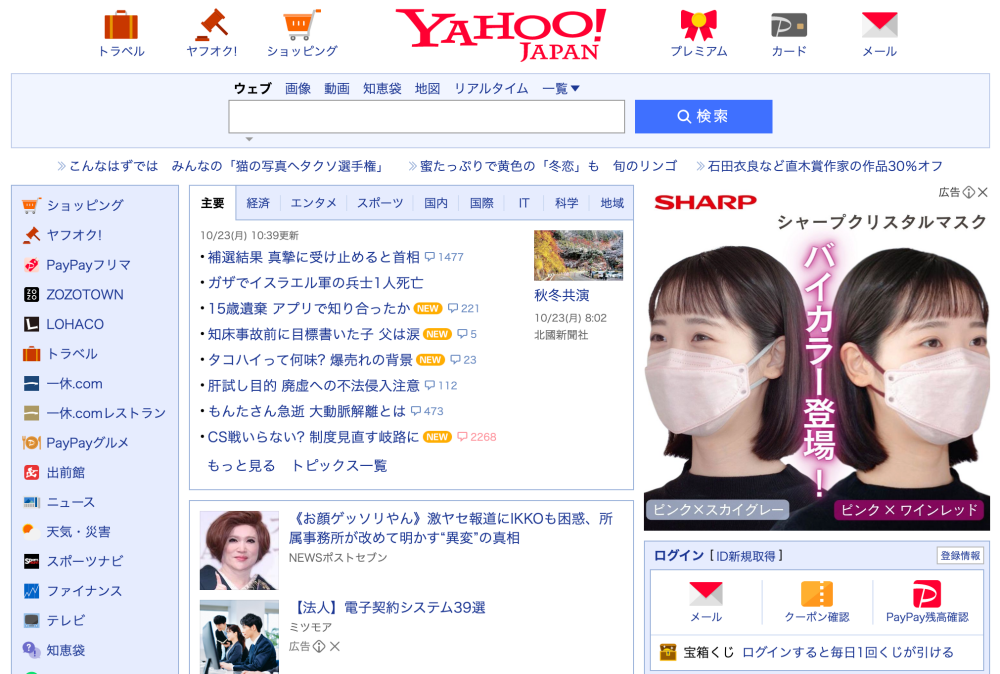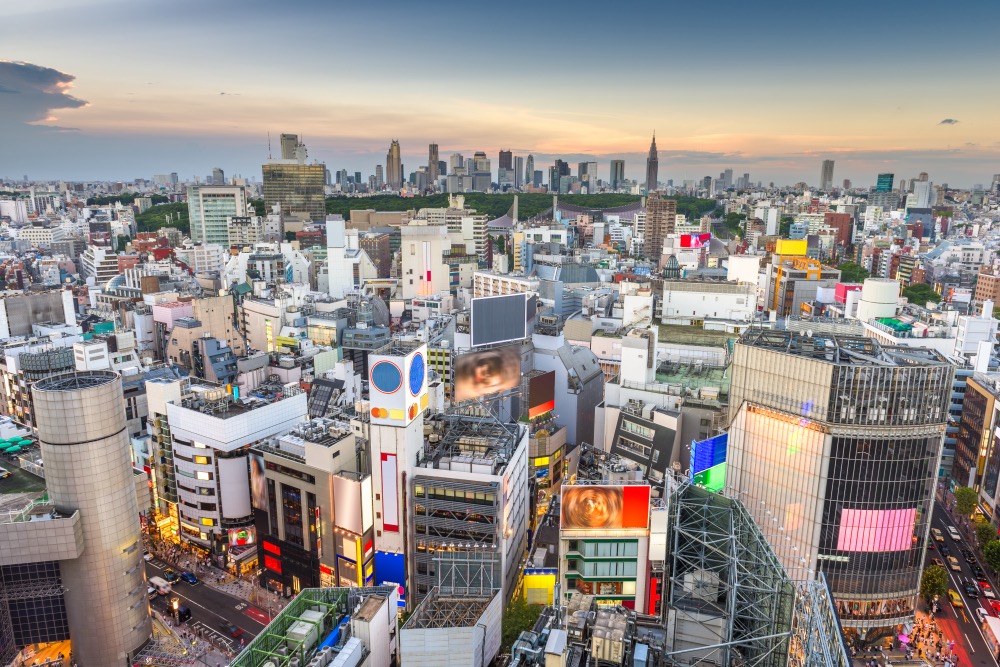
Yahoo Japan website
 How do trends in digital design aesthetics differ between the two countries?
As you’d expect, customer experience remains at the heart of digital design aesthetics in both markets.
A big difference I’ve observed is the approach to content development. In the UK there has been an increasing trend of ‘less is more’. The healthcare space is also becoming far more aligned to consumer-style campaigns. In Japan, however, the dense content of a product page may be disorientating to a UK customer, but this amount of copy and imagery provides the amount of information Japanese consumers are seeking.
What challenges have you faced in integrating brand narratives for products or services in both the UK and Japan?
One example that immediately springs to mind is designing launch strategies for companies who are either new to the market or are well-established but launching a new product in a specific market for the first time.
As I’ve mentioned, companies in the UK often favour a bold and brave brand narrative from the get-go to rapidly gain share of voice and credibility. In contrast, Japanese audiences are more receptive to brands that enter a market respectfully and build brand loyalty over time.
Japan’s age breakdown is also an incredibly important factor for brands to integrate into their campaign strategies.
How do social media engagement strategies differ between the UK and Japanese audiences?
LINE is a standout difference in Japan. Interestingly, Twitter also ranks higher, outperforming all of Meta’’s platforms. LINE and Twitter are often the preferred media platforms for following corporate accounts and acquisition marketing. In contrast, Meta platforms and LinkedIn play a far more important role in UK marketing strategies.
Social media marketing calendars also look very different across the two countries. Japan’s seasonality and unique set of holidays, celebrations, and events are very specific to their market.
Moving forward, we expect to see a continued emphasis on video content being produced for many of the biggest social media apps in Japan, whether this be in the form of stories posts or for use in paid social and digital advertising.
In terms of user experience, what cultural considerations do you account for when designing for Japanese versus UK audiences?
Taking into account cultural context is vital to creating a successful user experience. We consider local preferences for aspects such as colour psychology, typography, hierarchy, navigation, and user platforms.
In Japan, the initial introduction is very important. You just need to look at the intricacies of business card-exchanging etiquette. These welcoming principles and the tolerance of Japanese audiences to process a lot of information in small spaces are just a couple of examples of these cultural nuisances.
What differences have you noticed in mobile usage patterns between UK and Japanese consumers?
Japan is a mobile-first country when it comes to accessing information. Japan users contribute more to the app economy through in-app purchases than users from any other country in the world. I would expect to see significant growth in the health and mental wellness sector, leveraging sensors, artificial intelligence, and data analytics to provide a highly personalised experience.
Are there any digital platforms or tools that are popular in Japan but less so in the UK, or vice versa?
The classic examples would be Yahoo! JAPAN and LINE. We all know what Google is, and the chances are people have heard about Yahoo, but they might not be familiar with Yahoo! JAPAN, which is made specifically for a Japanese audience.
LINE is Japan’s most popular app allowing users to do things like access news, music, and blogs, make payments, shop, trade NFTs, and even schedule a doctor’s appointment. It’s a lot more than a simple messaging app, which makes it hugely popular for running ad campaigns.
What localization strategies have proved most effective for your campaigns in Japan?
It all starts with thorough market research to understand the specific Japanese customer behaviours, cultural patterns, and linguistic specifics. Using these insights, we may also be identifying local partners and influencers. Our localisation strategies go far beyond mere translation and there is certainly no one size fits all approach.
From a future-gazing perspective, where do you see the biggest growth or change opportunities in the digital landscapes of the UK and Japan?
Japan found itself missing out on the rise of Web2 by failing to produce a single tech giant among the ranks of Google, Meta, and Amazon. Determined not to make the same mistake, The Japanese government is strategically positioning itself as a global leader in the Web3 industry.
If Japan and the UK are able to exploit the potential of Web3, it will be a huge step into a new digital era for both countries.
How do trends in digital design aesthetics differ between the two countries?
As you’d expect, customer experience remains at the heart of digital design aesthetics in both markets.
A big difference I’ve observed is the approach to content development. In the UK there has been an increasing trend of ‘less is more’. The healthcare space is also becoming far more aligned to consumer-style campaigns. In Japan, however, the dense content of a product page may be disorientating to a UK customer, but this amount of copy and imagery provides the amount of information Japanese consumers are seeking.
What challenges have you faced in integrating brand narratives for products or services in both the UK and Japan?
One example that immediately springs to mind is designing launch strategies for companies who are either new to the market or are well-established but launching a new product in a specific market for the first time.
As I’ve mentioned, companies in the UK often favour a bold and brave brand narrative from the get-go to rapidly gain share of voice and credibility. In contrast, Japanese audiences are more receptive to brands that enter a market respectfully and build brand loyalty over time.
Japan’s age breakdown is also an incredibly important factor for brands to integrate into their campaign strategies.
How do social media engagement strategies differ between the UK and Japanese audiences?
LINE is a standout difference in Japan. Interestingly, Twitter also ranks higher, outperforming all of Meta’’s platforms. LINE and Twitter are often the preferred media platforms for following corporate accounts and acquisition marketing. In contrast, Meta platforms and LinkedIn play a far more important role in UK marketing strategies.
Social media marketing calendars also look very different across the two countries. Japan’s seasonality and unique set of holidays, celebrations, and events are very specific to their market.
Moving forward, we expect to see a continued emphasis on video content being produced for many of the biggest social media apps in Japan, whether this be in the form of stories posts or for use in paid social and digital advertising.
In terms of user experience, what cultural considerations do you account for when designing for Japanese versus UK audiences?
Taking into account cultural context is vital to creating a successful user experience. We consider local preferences for aspects such as colour psychology, typography, hierarchy, navigation, and user platforms.
In Japan, the initial introduction is very important. You just need to look at the intricacies of business card-exchanging etiquette. These welcoming principles and the tolerance of Japanese audiences to process a lot of information in small spaces are just a couple of examples of these cultural nuisances.
What differences have you noticed in mobile usage patterns between UK and Japanese consumers?
Japan is a mobile-first country when it comes to accessing information. Japan users contribute more to the app economy through in-app purchases than users from any other country in the world. I would expect to see significant growth in the health and mental wellness sector, leveraging sensors, artificial intelligence, and data analytics to provide a highly personalised experience.
Are there any digital platforms or tools that are popular in Japan but less so in the UK, or vice versa?
The classic examples would be Yahoo! JAPAN and LINE. We all know what Google is, and the chances are people have heard about Yahoo, but they might not be familiar with Yahoo! JAPAN, which is made specifically for a Japanese audience.
LINE is Japan’s most popular app allowing users to do things like access news, music, and blogs, make payments, shop, trade NFTs, and even schedule a doctor’s appointment. It’s a lot more than a simple messaging app, which makes it hugely popular for running ad campaigns.
What localization strategies have proved most effective for your campaigns in Japan?
It all starts with thorough market research to understand the specific Japanese customer behaviours, cultural patterns, and linguistic specifics. Using these insights, we may also be identifying local partners and influencers. Our localisation strategies go far beyond mere translation and there is certainly no one size fits all approach.
From a future-gazing perspective, where do you see the biggest growth or change opportunities in the digital landscapes of the UK and Japan?
Japan found itself missing out on the rise of Web2 by failing to produce a single tech giant among the ranks of Google, Meta, and Amazon. Determined not to make the same mistake, The Japanese government is strategically positioning itself as a global leader in the Web3 industry.
If Japan and the UK are able to exploit the potential of Web3, it will be a huge step into a new digital era for both countries.
 How do you keep abreast of the rapidly changing digital landscapes in both countries?
KVA was the first agency to create what we call our ‘Innovation Lab’. We have a team of in-house industry experts who have time and budget each month to research digital trends, experiment with technology, and prototype solutions. This means we are several years ahead of other digital agencies when it comes to innovation.
Our Innovation Lab team originally started in the UK but has since expanded into KVA Japan. The two teams love working collaboratively but the constant competitive desire to out geek each other is very real!
Our client partners really value our Innovation Lab because it not only gives them instant access to best-in-class innovation, but they love geeking out with us and becoming inspired with new ideas.
How do you keep abreast of the rapidly changing digital landscapes in both countries?
KVA was the first agency to create what we call our ‘Innovation Lab’. We have a team of in-house industry experts who have time and budget each month to research digital trends, experiment with technology, and prototype solutions. This means we are several years ahead of other digital agencies when it comes to innovation.
Our Innovation Lab team originally started in the UK but has since expanded into KVA Japan. The two teams love working collaboratively but the constant competitive desire to out geek each other is very real!
Our client partners really value our Innovation Lab because it not only gives them instant access to best-in-class innovation, but they love geeking out with us and becoming inspired with new ideas. 
